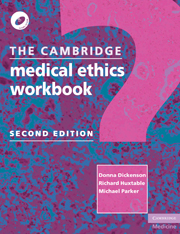Book contents
- Frontmatter
- Contents
- List of cases
- List of papers
- Preface to the second edition
- Preface to the first edition
- Cases in medical ethics and law: an interactive tutorial
- 1 Death and dying: decisions at the end of life
- 2 Reproduction: decisions at the start of life
- 3 Genetics: information, access and ownership
- 4 Medical research: participation and protection
- 5 Mental health: consent, competence and caring
- 6 Long-term care: autonomy, ageing and dependence
- 7 Children and young people: conflicting responsibilities
- 8 Resource allocation: justice, markets and rationing
- 9 Thinking about ethics: autonomy and patient choice
- Appendix 1 Study guide for teachers
- Appendix 2 Using keywords to explore this book
- Bibliography
- Index
1 - Death and dying: decisions at the end of life
- Frontmatter
- Contents
- List of cases
- List of papers
- Preface to the second edition
- Preface to the first edition
- Cases in medical ethics and law: an interactive tutorial
- 1 Death and dying: decisions at the end of life
- 2 Reproduction: decisions at the start of life
- 3 Genetics: information, access and ownership
- 4 Medical research: participation and protection
- 5 Mental health: consent, competence and caring
- 6 Long-term care: autonomy, ageing and dependence
- 7 Children and young people: conflicting responsibilities
- 8 Resource allocation: justice, markets and rationing
- 9 Thinking about ethics: autonomy and patient choice
- Appendix 1 Study guide for teachers
- Appendix 2 Using keywords to explore this book
- Bibliography
- Index
Summary
Values and goals at the end of life
Rather than reaching a more finely honed consensus about the values and practices that undergird end of life care, conflict has come to dominate the discussion. The consequences are serious for patients, health care providers, family members, and society.
(Dubler, 2005, p. 19)Death is an unavoidable fact of life. However, the manner in which we each will die is a matter of great concern and conjecture, not least given the considerable advances presented to us by modern medicine. It is nowadays possible for us to delay death and, in many cases, to enable those who would previously have died prematurely to recover and to live full and healthy lives. Such techniques also allow us to exert a greater degree of control over the processes of dying, even when full recovery is not possible. This means that there are people who can now be kept alive by medical interventions but who will never recover sufficiently to live an independent, or in some cases even a conscious, life as a result. There are also patients for whom medical interventions make no (or no appreciable) difference to their suffering – and, sometimes, these patients insist that they would rather die than endure their current existence.
The occurrence of such requests, along with the opportunities and challenges that modern medical techniques simultaneously present, raise a host of important ethical questions. In this chapter we will explore various dilemmas that arise in end-of-life care.
- Type
- Chapter
- Information
- The Cambridge Medical Ethics Workbook , pp. 1 - 32Publisher: Cambridge University PressPrint publication year: 2010

